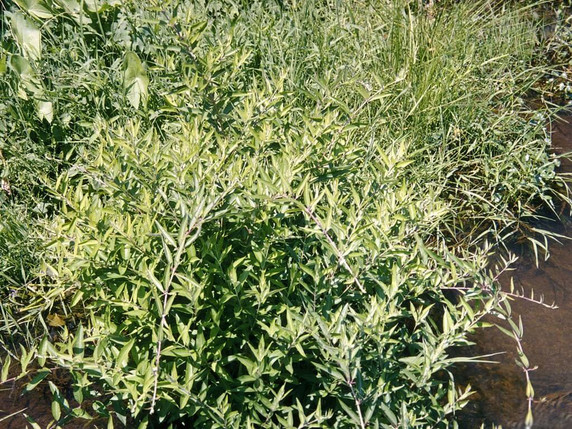Decodon verticillatus - SWAMP LOOSESTRIFE (WATER WILLOW)
This native loosestrife grows upright, but the branches arch down and can root when they touch the ground. It boasts attractive pink-rosy flowers and a woody base. suitable for bigger areas.
This wildflower can spread rapidly and is very suitable for larger areas. It's best used for naturalizing in bigger waterside landscaping. The willow-like leaves arch gracefully over the water's edge. Offers good support for wildlife such as bees, butterflies, ducks and muskrats.
Combine it with other water plants or grasses.
Pictures copyright: 1) US Perennials 2) detail Flickr - InAweofGod'sCreation, 3) the whole habitus - Wikipedia Commons, Forestry Images
Blooming Time: July to August
Size: 4-6’ tall and wide
USDA Zones: 3 to 9
Culture: full sun, half shade, water edge, bigger ponds or bigger wet areas
Moisture Needs: moist to wet, shallow water
Origin: native wildflower to Eastern and central North America, grows naturally in mucky, peaty, or sandy wet soil or wet sea shores. Can be found in high quality habitats. See the USDA distribution map.
Deer/Rabbit Resistant: yes / yes
Attracts Butterflies or Pollinators: offers nectar to honeybees, bumblebees, Swallowtail butterflies, and probably other insects. The caterpillars of Hydrangea Sphinx and Pearly Wood Nymph feed on the foliage, and caterpillars of the Burdock Borer Moth and Decodon Borer Moth bore through the stems. The range of the rare Decodon Borer Moth is restricted to the northeastern United States.
Attracts Hummingbirds: no, but the seed capsules are eaten by several ducks - the Mallard, Black Duck, Blue-Winged Teal, Green-Winged Teal, and Wood Duck.
Pot Size: 3.5" x 4" perennial pot (1.22 pt/580 ml)

Decodon verticillatus - SWAMP LOOSESTRIFE (WATER WILLOW)
This native loosestrife grows upright, but the branches arch down and can root when they touch the ground. It boasts attractive pink-rosy flowers and a woody base. suitable for bigger areas.
This wildflower can spread rapidly and is very suitable for larger areas. It's best used for naturalizing in bigger waterside landscaping. The willow-like leaves arch gracefully over the water's edge. Offers good support for wildlife such as bees, butterflies, ducks and muskrats.
Combine it with other water plants or grasses.
Pictures copyright: 1) US Perennials 2) detail Flickr - InAweofGod'sCreation, 3) the whole habitus - Wikipedia Commons, Forestry Images
Blooming Time: July to August
Size: 4-6’ tall and wide
USDA Zones: 3 to 9
Culture: full sun, half shade, water edge, bigger ponds or bigger wet areas
Moisture Needs: moist to wet, shallow water
Origin: native wildflower to Eastern and central North America, grows naturally in mucky, peaty, or sandy wet soil or wet sea shores. Can be found in high quality habitats. See the USDA distribution map.
Deer/Rabbit Resistant: yes / yes
Attracts Butterflies or Pollinators: offers nectar to honeybees, bumblebees, Swallowtail butterflies, and probably other insects. The caterpillars of Hydrangea Sphinx and Pearly Wood Nymph feed on the foliage, and caterpillars of the Burdock Borer Moth and Decodon Borer Moth bore through the stems. The range of the rare Decodon Borer Moth is restricted to the northeastern United States.
Attracts Hummingbirds: no, but the seed capsules are eaten by several ducks - the Mallard, Black Duck, Blue-Winged Teal, Green-Winged Teal, and Wood Duck.
Pot Size: 3.5" x 4" perennial pot (1.22 pt/580 ml)






